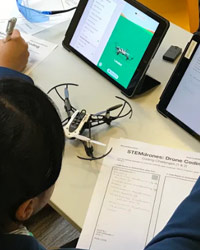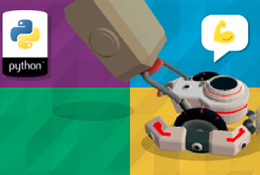Educational robots for Y3 and Y4
 RobotFun
RobotFunThere are many different educational robots available that are great for introducing Y3 and Y4 children to the wonderful world of coding. It is possible to find something for all ages, abilities and budgets! Here at RobotFun we’re always on the lookout for exciting new robots and we’ve acquired examples of quite a few.
In this article we’ll be taking a quick look at a couple of robots that feature in our school workshops.
Ozobot Evo
OzobotEvo is a small, round and very friendly robot, about 25mm in diameter, and 25mm tall. Underneath it has 7 line sensors and a single colour sensor. It is really good at following lines, which may be on paper or drawn using an iPad app. It also has one colour sensor, four proximity sensors, six programmable LED lights and a small speaker. Ozobots are able to understand colour changes as instructions, making them effectively programmable by drawing. For example, a bit of blue followed by a bit of red means 'turn around'. A green-red-green-red combination says 'do a cool trick'. Some codes are reversible - red-green-red-green is a different cool trick. Ozobot tracks and colour codes to program them are also supported using an iPad app. Ozobots are also able to support Ozobot Blockly, which is a variant of Scratch. The editor is graded, from simple levels that have limited functionality and use graphical blocks, to a full implementation complete with variables, mathematical expressions, subroutines and functions. Python support is being developed. This is available for testing but the implementation is not quite yet complete. Ozobot Blockly works on any device with a web browser. Python programming is done using Chrome, which has to be running on a Windows PC, Mac or Chromebook. Because of the increased security of web browsers on phones and tablets, Android and iOS devices are not currently supported for Python programming.
A large number of classroom activities are available direct from Ozobot and users are encouraged to share their contributions. It also has several free, 3D printable accessories.
Overall, it is a really excellent robot. The only downside is its current price, which has recently shot up. At the time of writing, if you can find one, an Ozobot Evo sells for around £159. Fortunately, there is a way of enjoying the programmability of Ozobot Evo without spending any money. Metabot is an Augmented Reality Ozobot Evo. You can use Ozobot Blockly to write a program and then see it being executed by a virtual Ozobot on a smart phone or tablet. An image of the robot is projected onto whatever the phone camera is pointed at.

Edison
Edison is best described as a small, orange, driving base, with two driven wheels and a skid. It is compatible with Lego. It is equipped with line, ambient light, proximity and sound/vibration sensors. By way of outputs there are the aforementioned motors, a couple of red LEDs and a small but surprisingly musical speaker. It also has a pair of infra-red transceivers that are able to understand many remote controls and can also communicate with other Edisons. Edison also has the capability to scan large bar codes by driving across them. The bar codes are used for two purposes. Firstly, they can tell the robot to program itself for several common robot algorithms, such as line following or avoiding obstacles. Secondly, a different set of bar codes can be used to teach the robot to identify specific IR messages from remote controls, so you can choose which button to press when you want the robot to turn right or drive forward, for example.
Edison’s makers have given a lot of thought to its use in education. Here are some of the reasons why it is great for use in the classroom:
Individually it is inexpensive (around £45).
Sensibly priced packs of 10 and 20 robots are available.
If you’re not into Lego robotics, the EdCreate pack of two robots and some Lego compatible parts is a great way to start.
It is easily repairable.
Spare parts are available, and are cheap.
It takes 4 alkaline AAA batteries.
It is highly programmable, supporting graphical and textual block languages, and Python.
All programming is done using web apps.
Edison doesn’t have either WiFi or Bluetooth. To connect it to a computer or tablet, a special cable with a standard audio plug on one end and a rubber connector that plugs in underneath Edison on the other. To download a program into Edison an audio representation of the program is created by the web app and downloaded by the web browser. The web app then plays this file. The squeaks and squarks are turned into flashes of light at the robot end of the cable, and these are picked up by Edison’s line following sensor. For this reason, the only requirement on the programming device is that it must have a 3.5 mm audio connector, and the volume control on the device is at maximum.
At RobotFun we’ve used Edison successfully in workshops for KS2, KS3 and KS4 children, and recommend it highly for school use.

If you are interested in hearing a bit more about how RobotFun can help you with planning your next school visit then why not get in touch here.
Robotics Workshop
RobotFun provides robotics based programming workshops for schools, suitable for Early Years through to KS4, using state of the art robots. We visit you and bring everything needed for the workshop(s). All you need to provide are the children!
view details..
Programming virtual robots
Brand New - Robot programming workshops that can be run entirely virtually. Two types are offered, Scratch based (best for KS2) and Python based (best for KS3).
view details..
Educational Robotics With The Raspberry Pi
 Why is the Raspberry Pi good for robotics in schools?
Why is the Raspberry Pi good for robotics in schools?
STEM coding workshops
 STEMbotics gives students an introduction to the world of STEM with opportunities to design, build and code their own unique robots
STEMbotics gives students an introduction to the world of STEM with opportunities to design, build and code their own unique robots
STEM drone coding workshops
 The STEMdrones workshop gives students an introduction to drones through code and algorithms, and principals in engineering and physics
The STEMdrones workshop gives students an introduction to drones through code and algorithms, and principals in engineering and physics
Educational Robotics With The Raspberry Pi
 Why is the Raspberry Pi good for robotics in schools?
Why is the Raspberry Pi good for robotics in schools?
We’re having a DRONEday!
 Having a DRONEday is a cost-effective way for you to deliver coding. You book us, we do the rest!
Having a DRONEday is a cost-effective way for you to deliver coding. You book us, we do the rest!




 Subscribe
Subscribe